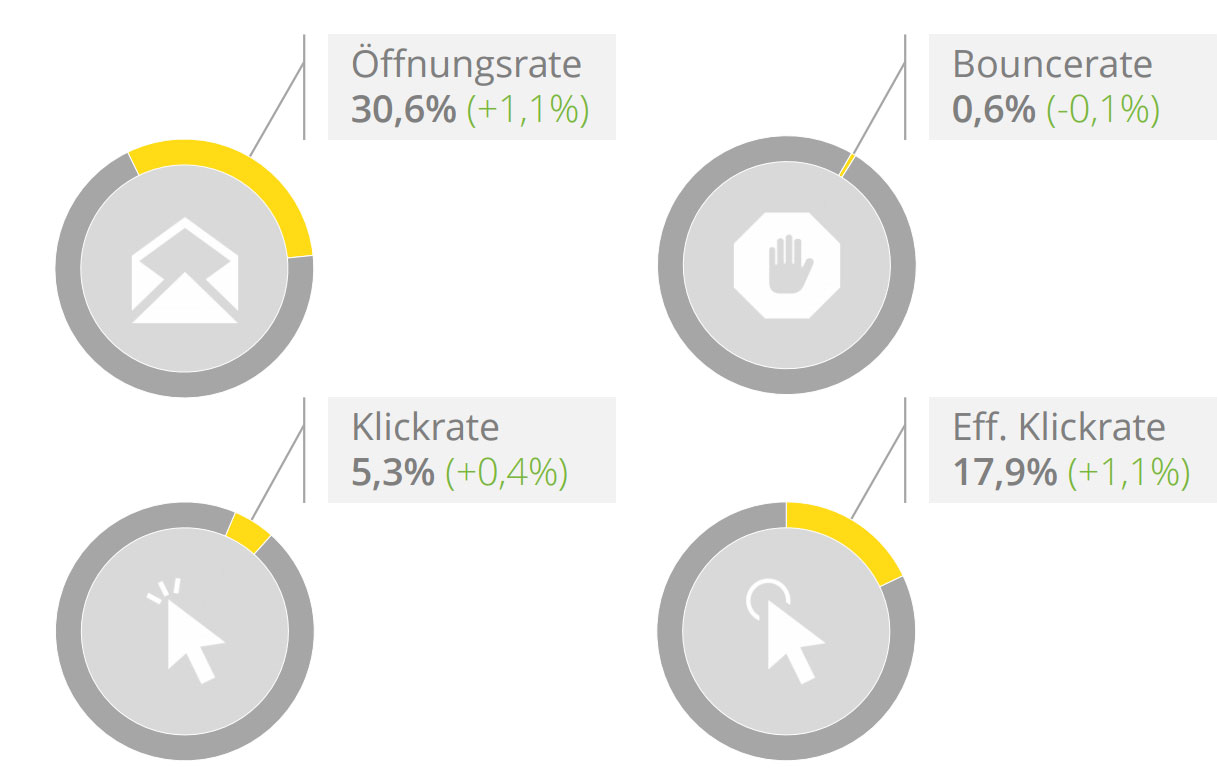The role of email marketing in a mobile world
Reaching digital natives with email is a challenge.Emails are annoying. We receive hundreds of them every day. And we ignore newsletters more than we read them. Nevertheless, e-mail is still one of the most frequently used forms of advertising in online marketing. A study by newsletter provider "Newsletter2Go" reveals that email marketing is used by more than 80% of companies [...]

Reaching digital natives with email is a challenge.E-mails are a pain in the neck. We receive hundreds of them every day. And we ignore newsletters more than we read them. Nevertheless, e-mail is still one of the most frequently used forms of advertising in online marketing. A study by the newsletter provider "Newsletter2Go" shows that e-mail marketing is an integral part of the communication mix for over 80% of companies.The current state of email marketing For the study, 750 customers were asked about their current use of e-mail marketing. These included many online retailers, SMEs, associations and agencies. 89% of them said they would continue to professionalize email marketing in the future. In addition, 44% want to invest more in their e-mail marketing activities. This clearly shows that the majority of respondents see great opportunities in this area.This statement is also supported by the study from Inxmail - another provider of email marketing solutions.The rates are improvingIn its benchmark published in September, Inxmail analyzed the key figures of over 1,000 customers with the target markets of Germany, Austria and Switzerland. In total, the company took a close look at several tens of thousands of newsletters with a total sending volume of several billion emails from 2013 to 2015. At first glance, it is noticeable that the key figures have improved over the years. This can be seen in the open rates, click rates, and bounce rates. A change can also be seen in the business areas. Mailings with the B2C target group generally perform better than mailings with the B2B target group.

Key figures for 2015. Values in parentheses represent the development compared with the previous year. The right shipping dayThe right day and time are often decisive for the success of a mailing. Inxmail also examined this factor and found that the open rate for the B2B target group tends to increase slightly over the course of the week. Mailings sent on Friday have the highest open rate, while those sent on Saturday have the lowest. In the B2C sector, on the other hand, the open rate fluctuates considerably over the course of the week. While it starts quite high on Monday, it decreases in the course of the week until Friday and reaches its highest value on Saturday. It can be assumed that e-mails are opened within the first few hours of being sent. Thus, mailings also reliably reach their recipients on Saturdays and Sundays.The right shipping time As far as the time of day is concerned, mailings sent after midnight have particularly high open rates. One possible explanation for this is that they are placed quite high up in the recipients' inboxes when they arrive at work in the morning. Sending times from early morning to midday have the worst opening rate during the week. This can be explained by the fact that recipients do not have time to read emails in the morning during their day-to-day business and therefore do not open them at all. Central component in push communication The results of the two studies clearly show that e-mail marketing has proven itself. Cyrill Gross, Key Account Manager and Senior Consultant at Mayoris AG, is also convinced of this: "E-mail still has the best ROI of all online channels. In addition, the reach belongs 100 percent to the own company." Therefore, e-mails are the central component in automated push communication along the customer lifecycle in particular. "Because only via e-mails can customers be clearly identified across the board and directly addressed electronically," says Gross.The email in the mobile worldAs effective as email may be, its importance has changed because of the rise of mobile devices. And with it, user behavior in particular. "Today, e-mails are read everywhere, often in situations where only a few minutes are available, for example while waiting at a bus or train stop. This further reduces the attention span, and only the really relevant messages are actually read. In addition, many e-mails are opened on multiple devices. First briefly on the smartphone and later on the tablet or computer," explains Gross.As a result, companies have to use a different display format and pay attention to the individual screen formats and their characteristics.The content countsContent is much more important than form. Especially in the mobile world, relevance and topicality are increasingly in focus. It is therefore important to ensure that short, comprehensible messages are conveyed. Ideally on a topic that is high on the recipient's list of personal priorities. Personalization and automation are thus gaining in importance. In addition, new technologies make it possible to integrate interactive elements directly into the e-mail. For example, a complete survey or the ordering of a product. This has the advantage of simplifying the process for the user and increasing the conversion rate.Classic newsletters are outParticular care must be taken with newsletters. Because today, the classic form has had its day. "The recipients want to be picked up where they are. Not only in their life cycle, but also in terms of location and emotion," explains Cyrill Gross. It would be better to rely on location-based marketing or transactional emails and contextual messages. However, this requires collecting more data and information about the customer, increasing effort and complexity. "Given the much better performance of such messages, it is worthwhile to use them, especially since even on the part of the large ISPs such as GMail and Hotmail, the open and click rates of a sender's mailings are used for sorting within the smart inboxes," advises Gross.Emails are not target group dependentSince e-mail is the most widespread online application, it is suitable for all target groups. "However, the decisive factor is not primarily the target group, but the allocation of the recipient to a customer segment or the status of the customer in his life cycle. The further this develops from initial contact to loyalty, the greater the importance of e-mail as a communication channel," explains Gross.This also applies to digital natives; they also accept advertising via e-mail better than that via social media.How the young generation uses e-mailHow do young people feel about email in the first place? "Tech-savvy youth use email daily or several times a week, especially on their smartphones. They need this professional correspondence, for example, to apply for jobs, to book trips, and to enter contests," answers Marcia Geiger, marketing all-rounder at the youth agency Jim & Jim.This target group is used to receiving emails because they have various social media accounts and online logins. However, they practically never communicate with each other via email. Usage increases with age, due to the increasingly professional environment.How to address teenagers in emailsFor marketers, reaching young people via email is therefore a challenge. "In particular, messenger services such as Whatsapp or Snapchat are competing with email marketing, as they reach young people in real time with direct messages and entice them with short-lived offers," explains Geiger.Those who still want to reach digital natives, who are exposed to the constant overflow of information, should focus on the aspects of personalization and individualization when preparing email campaigns. "Continuous personal addressing and language adapted to digital natives is indispensable here," says Geiger. It should also be remembered that there are different target groups to address within the digital natives, which is why email campaigns should be defined in terms of gender, age and interest. They should also stand out from standardized and automatically generated spam e-mails and highlight the key message or benefit for the recipient in the header. Ultimately, it is the benefit or profit that seems relevant to the young person that makes them open the email and respond.A newsletter to the boysDigital natives usually make a conscious decision to receive a newsletter. In order to keep this target group in the distribution list, it is essential to send not too many, but also not too few newsletters. "Unlike adults, young people usually have hundreds of other messages to read besides emails. Therefore, the tolerance threshold for unprofitable and poorly designed newsletters is even lower among them," explains Marcia Geiger.Companies should therefore focus on the advantage of young people in their newsletters and put themselves in their shoes. Basically, expressive images, few animations and little text, but a clear and simple description apply.








